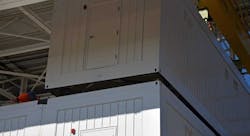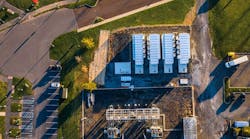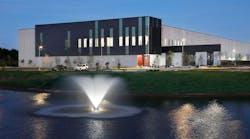FALLS TOWNSHIP, PA – The power towers loom overhead as you drive through the industrial zone along the Delaware River. These power lines tell of a storied past, when the site was home to a massive U.S. Steel plant that employed 10,000 workers. An ambitious team of data center developers believe these same towers provide the gateway to the future.
Keystone NAP is building an outpost of the new economy in the footprints of the old. It has just opened a unique data center on the former U.S. Steel site, combining the latest modular technology with savings on power and taxes. The startup is among a small but growing number of data center providers using pre-fab “building blocks” to enable innovative projects that are bringing data centers to new places.
Keystone is just one example of retooling old industrial facilities for Internet infrastructure. Google is converting an Alabama coal energy plant into its newest server farm. In Boston, The Markley Group is transforming a former Prince pasta factory. In Chicago, QTS is creating a data center from a former plant for the Sun-Times newspaper, after retooling former semiconductor plants into new server farms in Virginia and Dallas.
The theme in these projects is consistent: large buildings with good bones and lots of power. The Keystone NAP project in Pennsylvania is notable on both fronts.
A Power Play in Pa.
Power lines feeding the Keystone NAP facility at the former U.S. Steel campus. (Photo: Keystone NAP)
U.S. Steel has shuttered most of its Fairless Hills operation, where iron ore was off-loaded from ships and melted in blast furnaces to create cold rolled steel. It left behind some extraordinary infrastructure, including more than 2,000 acres of land, two major rail lines and the northmost navigable port on the Delaware River.Most importantly: the site has massive amounts of electricity, with four major power generation facilities feeding a microgrid with capacity of more than 2,000 megawatts of power.
“The infrastructure that was built to support the steel mill now supports our new (data center) tenants, with all its electrical infrastructure and all that redundancy,” said Shawn Carey, a co-founder as well as Senior VP of Sales and Marketing for Keystone NAP.
When you enter the data center building at Keystone NAP, you need to look up to see the data halls. The prefabricated modular data centers are stacked three-high, creating a tower nearly 40 feet high. This appears to be the first U.S. implementation of a three-high stack of modules, an approach pioneered by hosting giant OVH in 2012 in France.
The “building block” module for Keystone NAP is known as a KeyBlock, which joins two standard modules and measures roughly 45 feet long by 21 feet wide. Each module houses three CRACs (computer room air conditioners), which flood the room with cool air. A hot aisle containment system is created with vinyl curtains atop each row of cabinets, and a sliding door to enclose the entrance to the hot aisle. Customers can boost the power density by adding in-row cooling units as needed.
The first three-high stack of KeyBlock modules at Keystone NAP in Fairless Hills, Pa. (Photo: Keystone NAP)
Each module has two entrances – a front entrance used by customers to manage the servers and racks, and a rear entrance for Keystone NAP to service the power and cooling infrastructure. A security gate separates the two sections to provide access control.Keystone NAP has partnered with Schneider Electric on the modules, as well as the project’s power and cooling infrastructure and IT enclosures. Each KeyBlock is manufactured in North Carolina, trucked to the site, and dropped off at the Keystone NAP building, a 180,000 square foot structure that was once part of the steel mill operations. One element of the old steel infrastructure proved handy: a huge overhead crane, which is used to hoist the modules into place atop the stack.
Keystone NAP plans to deploy capacity in “stacks” of 12 modules, the first of which is in place and supporting customers. The company says it can fit up to 15 of these stacks into its facility. The building will include 13,000 square feet of office space, which is currently under construction.
“Our strategy for stacking KeyBlocks is just one of the ways Keystone NAP is taking an innovative approach to data center design,” said Keystone NAP co-founder and CEO Peter Ritz. “We are offering customers unprecedented flexibility to create the exact data center environment they need. By delivering those assets in modular form, we’re also guaranteeing cost efficiency and room for growth over time.”
Each stack has connections for water, power and network on the side of the base module. The power infrastructure is housed outside the building, where enclosures house UPS units and generators, which sit next to an on-site electrical substation.
69,000 Volts of Potential
Carey and Ritz previously worked together at Xtium, a Philadelphia-based cloud service provider that hosted its infrastructure with other providers (most notably at the SUPERNAP in Las Vegas). The pair saw an opportunity to operate their own data centers, and became intrigued with the potential of the former U.S. Steel site, now part of the Keystone Industrial Port Complex (KIPC).
They weren’t the first outfit to explore a data center at KIPC, which offers substantial tax advantages to attract tenants. In 2011 a data center startup named Steel Orca announced plans to develop an advanced data center at the site. After several years of planning, Steel Orca abandoned its effort to build at the U.S. Steel property, shifting its efforts to a former Pfizer pharmaceutical facility in South Brunswick, N.J.
Carey and Ritz connected with John Parker, who had done legal work for the Steel Orca project, and added local IT veteran Philip Lanctot to round out the Keystone NAP founding team.
The site’s ample power story begins with those 69,000 volt high-tension transmission lines feeding the campus. These are now carrying data as well as electricity, borne over an Optical Ground Wire (OPGW) placed at the top-most position of the tower. The OPGW shields conductors from lightning while providing a telecommunications path for dark fiber for the Keystone NAP, which built a meet-me-room at the entrance to the property.
Keystone NAP has access to electricity from four generation sources adjacent to the U.S. Steel property. (Image: Keystone NAP)
Keystone NAP likes to describe the campus as offering “extreme power.” The U.S. Steel site features a microgrid which connects to four separate power generation sources:
- The Dominion Energy Fairless Power Station sits along a major natural gas pipeline, and burns the gas to produce energy, with a capacity of up to 1,180 megawatts – enough electricity to power about 295,000 homes.
- The Wheelabrator Falls Inc. waste-to-energy facility processes up to 1,500 tons per day of municipal solid waste, with an electric generating capacity of 53 megawatts.
- The Exelon Fairless Hills Steam Generating Station is the second-largest landfill gas power plant in the U.S., tapping landfill gas from Waste Management’s nearby Tullytown and Grows landfills as its primary fuel source. It has a generating capacity of 60 megawatts.
- The PSE&G Mercer Generating Station, located immediately across the Delaware River on Duck Island, burns coal and natural gas and adds 747 megawatts of capacity to the power mix.
That provides Keystone NAP with an almost unlimited potential future supply of energy. For now, the company has 13 megawatts of capacity to the building, with the ability to expand to 30 megawatts. Of that, 1.2 megawatts of capacity is installed to support the first KeyBlock.
Keystone NAP touts its geography as an advantage: a power-rich property just 25 miles north of Philadelphia and 65 miles from Manhattan. It occupies a blank spot in the data center map between the two major cities.
Customers Are the Key
As such, it is adopting the Star Trek approach to site selection: To boldly go where no data center has gone before. It’s an approach that offers both risks and rewards. There is a strong trend towards data centers in places where they have not previously been seen, as the growth of Internet-connected businesses expands to suburbs and small towns, and improved connectivity brings the network closer together. On the other hand, sometimes the holes in the map are defined by customer preferences.
Inside one of the modular KeyBlock data halls.
Carey says Keystone NAP’s relatively low power cost – about 9.5 centers per kilowatt hour – has drawn solid interest from the healthcare customers seeking storage for large datasets and imagery, and from insurance companies and banks seeking data center space for business continuity.Keystone is a wholesale provider, and its game plan is to sell one KeyBlock per customer. One of its early customers is Xtium, which will offer space to customers with smaller space requirements, a common model for wholesale providers.
Carey says the company’s use of a pre-fabricated modular design allows it to commission new space within 90 days of a customer order. In the meantime, this approach allows them to manage their capital costs, using phased builds to match capacity and demand. And if that demand materializes, Keystone NAP can pursue a “buy as you grow” approach, building a digital bridge between the days of steel and the era of Big Data.






